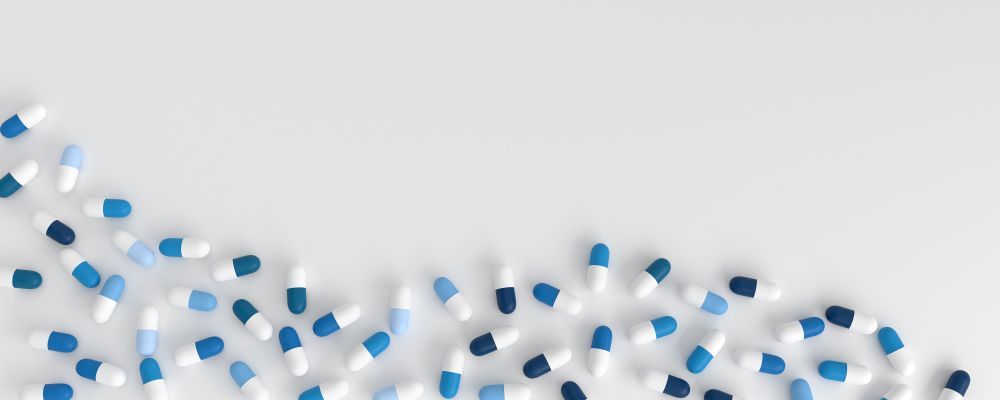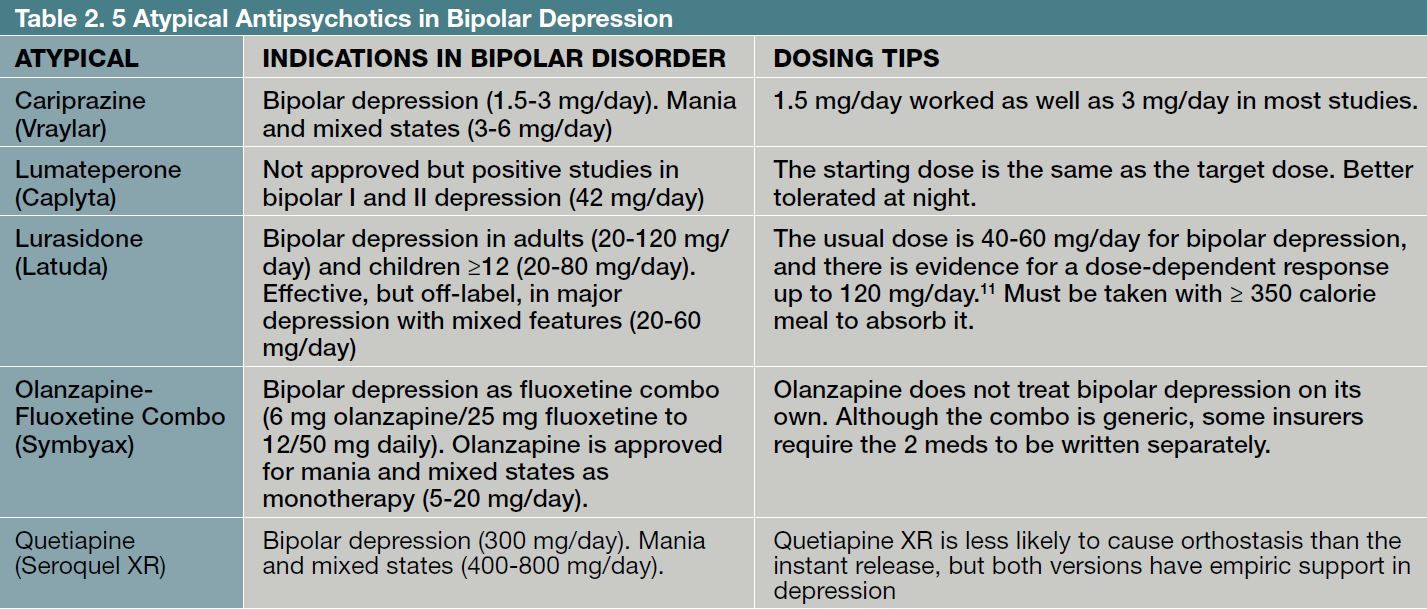Article
A New Option for Bipolar Depression
Author(s):
A preview of 3 pivotal trials suggests promising results, but there are reasons to wait before jumping in with this antipsychotic.
zeleniy9/AdobeStock

RESEARCH UPDATE
The FDA is reviewing 3 controlled trials of lumateperone (Caplyta) in bipolar depression. The results have not been published, but their bare bones have been presented at conferences. Here is what we know so far.
All 3 were large, randomized, placebo controlled, quadruple-blind trials in bipolar I and bipolar II depression. The first trial was negative, but lumateperone worked in the next 2 with a small to medium effect size (0.27-0.56). As with other atypicals in bipolar depression, lumateperone’s efficacy was evident as early as week 1 (Table 1).1-6
Negative trials are a common problem in multicenter studies like this one, which involved 58 centers. When each enter takes care of only a small number of patients, they tend to give those patients more time and attention. This inflates the placebo response, which in this case was 1.7 times greater than the placebo response in the positive trial.2 Negative results did not hold back the approval of other atypicals like cariprazine in bipolar depression, but lumateperone may not cross the finish line if the FDA finds flaws with its 2 positive studies.
The trials bring needed attention to bipolar II disorder, which was included along with bipolar I in each of the trials. Of the 4 atypicals approved in bipolar depression (cariprazine, lurasidone, quetiapine, and olanzapine-fluoxetine combo), only quetiapine and cariprazine were extensively studied in bipolar II depression, and only the quetiapine studies were positive.7 Table 2 lists 5 atypical antipsychotics in bipolar depression.
Lumateperone’s favorable trials remained positive when broken down into bipolar I and bipolar II subgroups. A fourth trial is underway that will test the drug in a third group: unipolar depression with mixed features. Currently, only lurasidone (Latuda) has robust data in that disorder.8
Lumateperone is a serotonin 5-HT2A antagonist, a mechanism it shares with asenapine, clozapine, olanzapine, risperidone, and quetiapine, as well as mirtazapine and trazodone. Unlike other antipsychotics, it has low affinity for the dopamine D2 receptor. Its occupancy there is 39%. In contrast, the next lowest is 60% occupance for clozapine and quetiapine, and most other antipsychotics register at above 60% occupancy.9 So far, this has translated to a lower rate of akathisia and extrapyramidal side effects in schizophrenia, and that benefit extended to the bipolar trials as well.
This profile resembles that of pimavanserin (Nuplazid), an antipsychotic with low dopamine occupancy that is an inverse agonist at serotonin 5-HT2A (“inverse agonists” do not block the receptor, but they cause it to act in ways opposite to an agonist). Pimavanserin is FDA-approved in psychosis due to Parkinson disease, and it has also shown potential in depression in a large, randomized, placebo-controlled augmentation trial.10
Lumateperone has a few drawbacks in bipolar disorder. It is costly, has never been teste din mania, and is only FDA-approved in schizophrenia. If approved, its main advantage over other atypical antipsychotics is likely to be tolerability. Lumateperone had low rates of akathisia, weight gain, metabolic disturbances, and prolactinemia in the short-term bipolar depression studies, as well as in the schizophrenia studies which lasted up to one year. Its main side effects are somnolence, nausea, dry mouth, and dizziness. The starting dose is the same as the target dose, and the same as the schizophrenia dose: 42 mg at night.
The Bottom Line
If approved, lumateperone will bring at least 2 qualities that are needed in the bipolar armamentarium: Efficacy in bipolar II depression and reasonable tolerability. Pending that, it is worth considering in patients with moderate to severe bipolar depression who have not responded to other options.
Dr Aiken is the Mood Disorders Section Editor for Psychiatric TimesTM, the Editor in Chief of The Carlat Psychiatry Report, and the Director of the Mood Treatment Center. He has written several books on mood disorders, most recently The Depression and Bipolar Workbook. He can be heard in the weekly Carlat Psychiatry Podcast with his co-host Kellie Newsome, PMH-NP.
The author does not accept honoraria from pharmaceutical companies but receives royalties from PESI for The Depression and Bipolar Workbook and from W.W. Norton & Co. for Bipolar, Not So Much.
References
1. Durgam S, Satlin A, Vanover KE, et al. Lumateperone in the treatment of bipolar depression: Efficacy across symptoms. Poster presentation, International Society for Bipolar Disorders Annual Conference, June 2020.
2. Press Release. Intra-cellular therapies announces positive topline results from study 402 evaluating lumateperone as adjunctive therapy in patients with bipolar depression, September 9, 2020.
3. ClinicalTrials.gov. Clinical Trial Evaluating ITI-007 (Lumateperone) as a Monotherapy for the Treatment of Bipolar Depression, April 2021.
4. ClinicalTrials.gov. Clinical trial evaluating iti-007 as an adjunctive therapy to lithium or valproate for the treatment of bipolar depression, July 2020.
5. ClinicalTrials.gov. Clinical trial evaluating lumateperone monotherapy in the treatment of bipolar depression or major depressive disorder.
6. ClinicalTrials.gov. Lumateperone monotherapy for the treatment of bipolar depression conducted globally, April 2021.
7. Yatham LN, Vieta E, Earley W. Evaluation of cariprazine in the treatment of bipolar I and II depression: a randomized, double-blind, placebo-controlled, phase 2 trial. Int Clin Psychopharmacol. 2020;35(3):147-156.
8. Suppes T, Silva R, Cucchiaro J, et al. Lurasidone for the treatment of major depressive disorder with mixed features: a randomized, double-blind, placebo-controlled study. Am J Psychiatry. 2016;173(4):400-407.
9. Vanover KE, Davis RE, Zhou Y, et al. Dopamine D2 receptor occupancy of lumateperone (ITI-007): a Positron Emission Tomography Study in patients with schizophrenia. Neuropsychopharmacology. 2019;44(3):598-605.
10. Fava M, Dirks B, Freeman MP, et al. A phase 2, randomized, double-blind, placebo-controlled study of adjunctive pimavanserin in patients with major depressive disorder and an inadequate response to therapy (CLARITY).J Clin Psychiatry. 2019;80(6):19m12928.
11. Chapel S, Chiu YY, Hsu J, Cucchiaro J, Loebel A. Lurasidone dose response in bipolar depression: a population dose-response analysis. Clin Ther. 2016;38(1):4-15.








